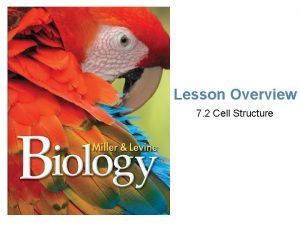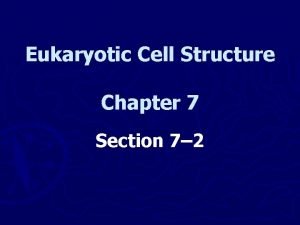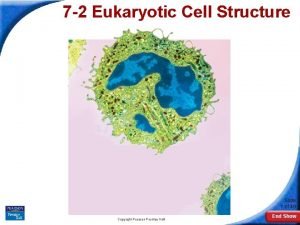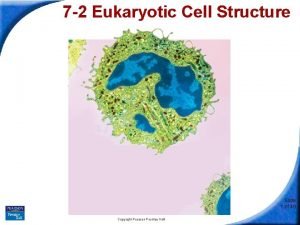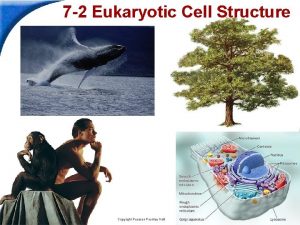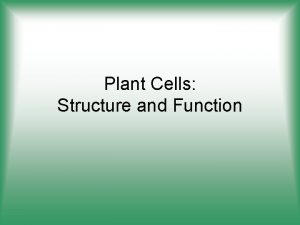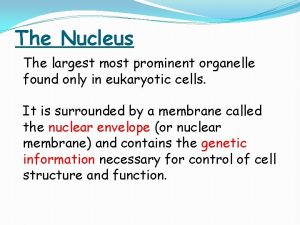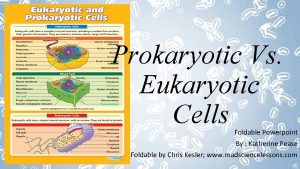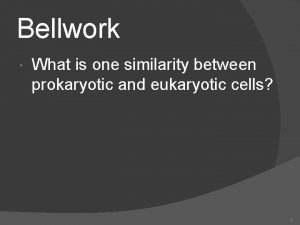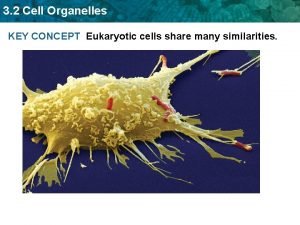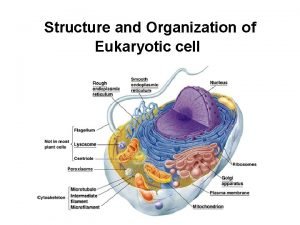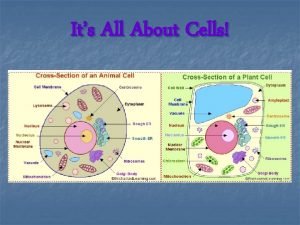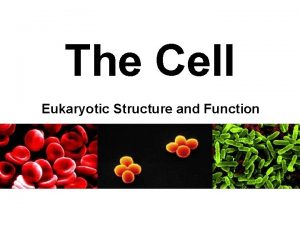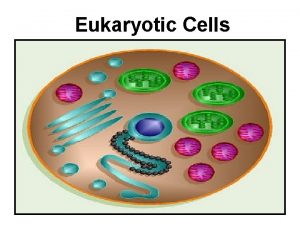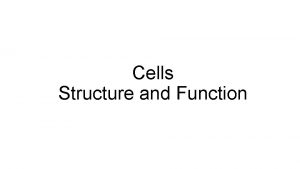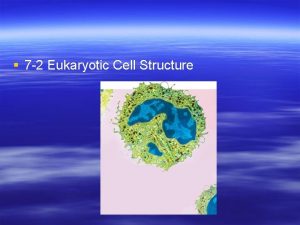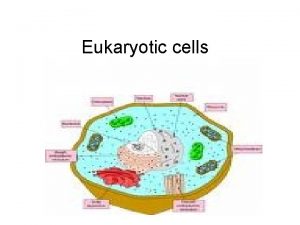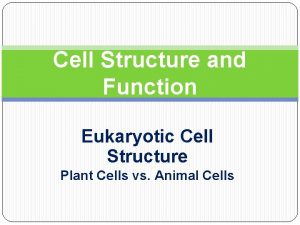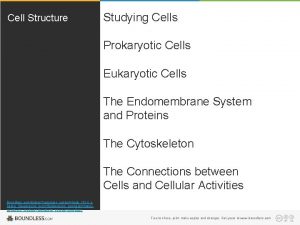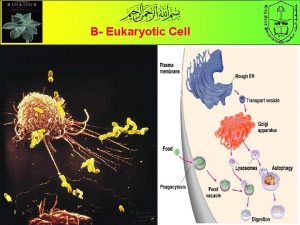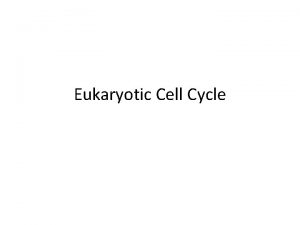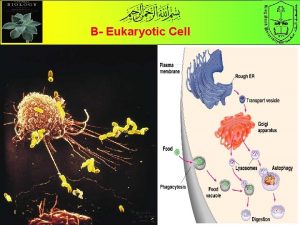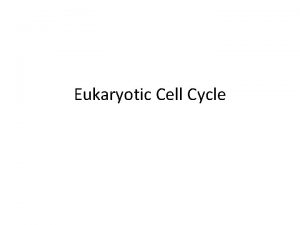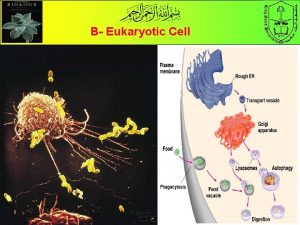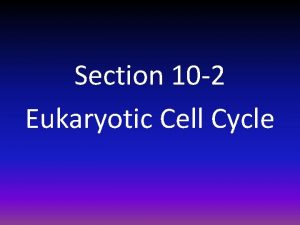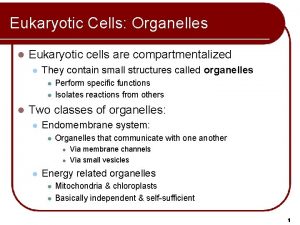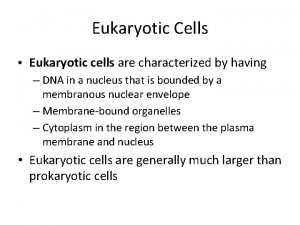Cell Structure Function Introduction to Cells Eukaryotic Cells






















- Slides: 22

Cell Structure & Function Introduction to Cells Eukaryotic Cells Prokarytoic Cells

Introduction to Cells l History – Robert Hooke (1600’s) first described cells in thin sections of cork that he examined under microscope – Robert Brown (1820) first to describe that a nucleus seemed to be associated with all cells (at least eukaryotic cells)

Introduction to Cells l History (continued) – Theodore Schwann & Matthias Schleiden (1839) advanced cell theory » All organisms are composed of cells » The cell is the basic unit of life » All cells arise from preexisting cells

Introduction to Cells l Cell Types – Prokaryotic – Eukaryotic l Sizes – Prokaryotic – Eukaryotic 0. 2 to 2. 0 microns 10 to 100 microns

Introduction to Cells l Size Determinants – Cell surface to volume relationships govern cell size – The smaller the cell the more efficiently materials can be transported into and within the cell – Cell must also be large enough to deal with information and metabolic requirements

Introduction to Cells

Introduction to Cells l Common Components to All – Plasma membrane – phospholipid bilayer that controls movement of substances into and out of cells – Ribosomes – site of protein synthesis – note ribosomes have both RNA & protein – Cytoplasm –matrix on interior of cell consisting of water soluble proteins and other materials – Nuclear material – DNA/Protein complex that stores information » Prokaryotic – circular » Eukaryotic – linear and in chromosomes

Eukaryotic Cells l Eukaryotic Cells – Larger than prokaryotic – More complex than prokaryotic – All multicellular organisms composed of eukaryotic cells – Eukaryotic cells composed of many internal structures called organelles

Eukaryotic Cells l l Endosymbiotic theory (Lynn Margullis – 1967) Evidence: – – Mitochondria & chloroplasts replicate via binary fision Mitochondria & chloroplasts have circular DNA Mitochondria & chloroplasts have 70 S (bacterial ribosomes) Mitochondria & chloroplasts start protein synthesis in the same way as prokaryotic cells – Mitochondria & chloroplasts DNA sequences of similar genes show greater relationships to prokaryotic genes

Eukaryotic Cells l l l Nucleus Mitochondria Chloroplast Endoplasmic reticulum (R & S) Golgi body l l l Lysosome Peroxisome Centrioles Vacuoles Flagella & cilia

Eukaryotic Cells

Eukaryotic Cells

Eukaryotic Cells l Nucleus – Regulates growth and reproduction of cell – Contains DNA and chromosomes l Nucleolus – Ribosomal RNA synthesis

Eukaryotic Cells l Mitochondria – Energy production in cell – Contains its own DNA (circular)

Eukaryotic Cells l Endoplasmic reticulum (rough and smooth) – Site of protein synthesis in cells – Start of protein export process – Connected to nuclear pores and Golgi body

Eukaryotic Cells l Golgi body – Sorting center for proteins in cell – Produces vesicles which fuse with plasma membrane

Eukaryotic Cells l Lysosome – Only in animal cells – Production of intracellular digestive enzymes – Involved with phagocytosis

Eukaryotic Cells l Peroxisomes – Peroxisomes are small rounded organelles found free floating in the cell cytoplasm. – Contain at least 50 enzymes and are separated from the cytoplasm by a lipid bilayer single membrane barrier. – Produce hydrogen peroxide which is toxic but is rapidly degraded by catalase

Eukaryotic Cells l Flagella & cilia – Involved with motility of cells – Composed of microtubules

Eukaryotic Cells l Vacuoles – Found only in plants – Large central organelle in plant cells – Regulates water in plant cells

Eukaryotic Cells l Chloroplast – Site of photosynthesis in plant cells – Has own DNA (circular) – Found only in plants

Eukaryotic Cells l l Endosymbiotic theory (Lynn Margullis – 1967) Evidence: – – Mitochondria & chloroplasts replicate via binary fision Mitochondria & chloroplasts have circular DNA Mitochondria & chloroplasts have 70 S (bacterial ribosomes) Mitochondria & chloroplasts start protein synthesis in the same way as prokaryotic cells – Mitochondria & chloroplasts DNA sequences of similar genes show greater relationships to prokaryotic genes
 Eukaryotic cells vs prokaryotic
Eukaryotic cells vs prokaryotic Prokaryotes vs eukaryotes venn diagram
Prokaryotes vs eukaryotes venn diagram Prokaryotic cells vs eukaryotic cells
Prokaryotic cells vs eukaryotic cells Prokaryotic cells
Prokaryotic cells Prokaryotic vs eukaryotic cell
Prokaryotic vs eukaryotic cell Linear chromosomes in eukaryotes
Linear chromosomes in eukaryotes Life
Life Eukaryotic cell animal cell
Eukaryotic cell animal cell Cell structure
Cell structure Section 7-2 eukaryotic cell structure
Section 7-2 eukaryotic cell structure Biology chapter 7 cell structure and function
Biology chapter 7 cell structure and function Section 7-2 eukaryotic cell structure
Section 7-2 eukaryotic cell structure Section 7-2 eukaryotic cell structure
Section 7-2 eukaryotic cell structure Section 7-2 eukaryotic cell structure
Section 7-2 eukaryotic cell structure Typical plant cell
Typical plant cell Most prominent organelle in eukaryotic cells
Most prominent organelle in eukaryotic cells Eukaryotic cells
Eukaryotic cells Similarities between prokaryotic and eukaryotic cells
Similarities between prokaryotic and eukaryotic cells Diff between prokaryotes and eukaryotes
Diff between prokaryotes and eukaryotes Similarity between prokaryotic and eukaryotic cells
Similarity between prokaryotic and eukaryotic cells Organelles in eukaryotic cells worksheet
Organelles in eukaryotic cells worksheet Eukaryotic cells
Eukaryotic cells Are chromosomes living or nonliving
Are chromosomes living or nonliving








